EMSD6017: Environmental Management for Sustainable Development
VerifiedAdded on 2023/06/10
|19
|5931
|280
Report
AI Summary
This report analyzes the sustainable factors that oil and gas companies need to plan and implement to protect their businesses and the natural environment. It evaluates sustainability implementation within the upstream, midstream, and downstream stages of oil and gas production, considering Sustainable Development Goals (SDGs) like life below water, no poverty, and responsible consumption. The report discusses the impact of full sustainable development implementation on the oil and gas sector and the environment, highlighting both the positive contributions (job creation, tax revenue) and the challenges (climate change, environmental footprint). It also addresses challenges faced by oil and gas companies, such as finite fossil fuel sources and regulatory changes, and explores possible future developments and present research in sustainability within the industry. The report emphasizes the need for the oil and gas industry to integrate sustainable practices to mitigate adverse impacts, improve operational efficiency, and contribute to poverty reduction and environmental protection.
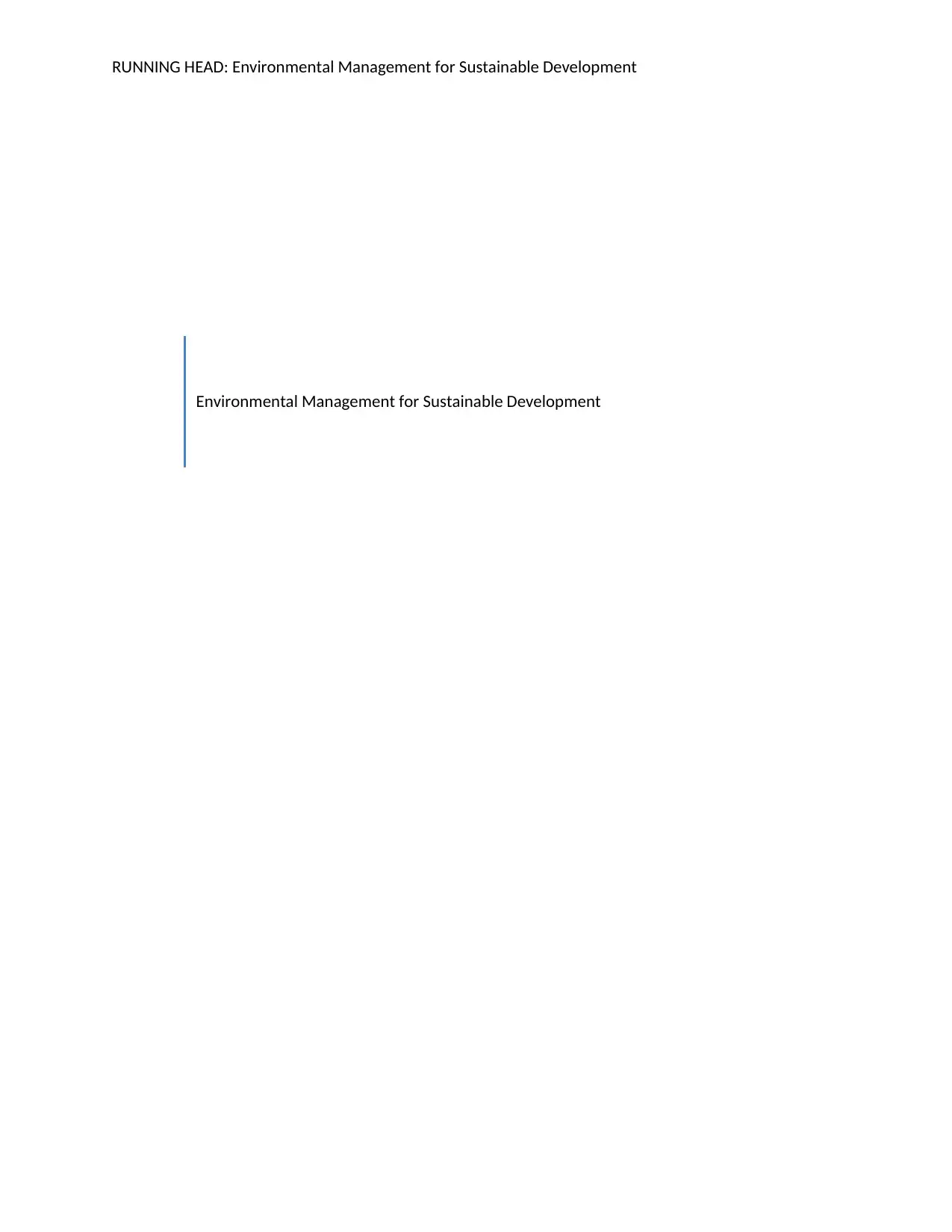
RUNNING HEAD: Environmental Management for Sustainable Development
Environmental Management for Sustainable Development
Environmental Management for Sustainable Development
Paraphrase This Document
Need a fresh take? Get an instant paraphrase of this document with our AI Paraphraser

Environmental Management for Sustainable Development 1
Executive Summary
The term sustainability can be defined as the process of change in which the alignment of
technological development, the direction of investment, the exploitation of resources and the
institutional change are all in synchronization. This report is focused on the analysis of the
sustainable factors that oil and gas companies require to plan for and implement for the purpose
of protecting their own businesses and the natural environment. This report further provides the
management and accommodation of the future changes by the oil and gas companies in
international, national and local laws and regulations, particularly those dealing with
sustainability and environment.
Executive Summary
The term sustainability can be defined as the process of change in which the alignment of
technological development, the direction of investment, the exploitation of resources and the
institutional change are all in synchronization. This report is focused on the analysis of the
sustainable factors that oil and gas companies require to plan for and implement for the purpose
of protecting their own businesses and the natural environment. This report further provides the
management and accommodation of the future changes by the oil and gas companies in
international, national and local laws and regulations, particularly those dealing with
sustainability and environment.
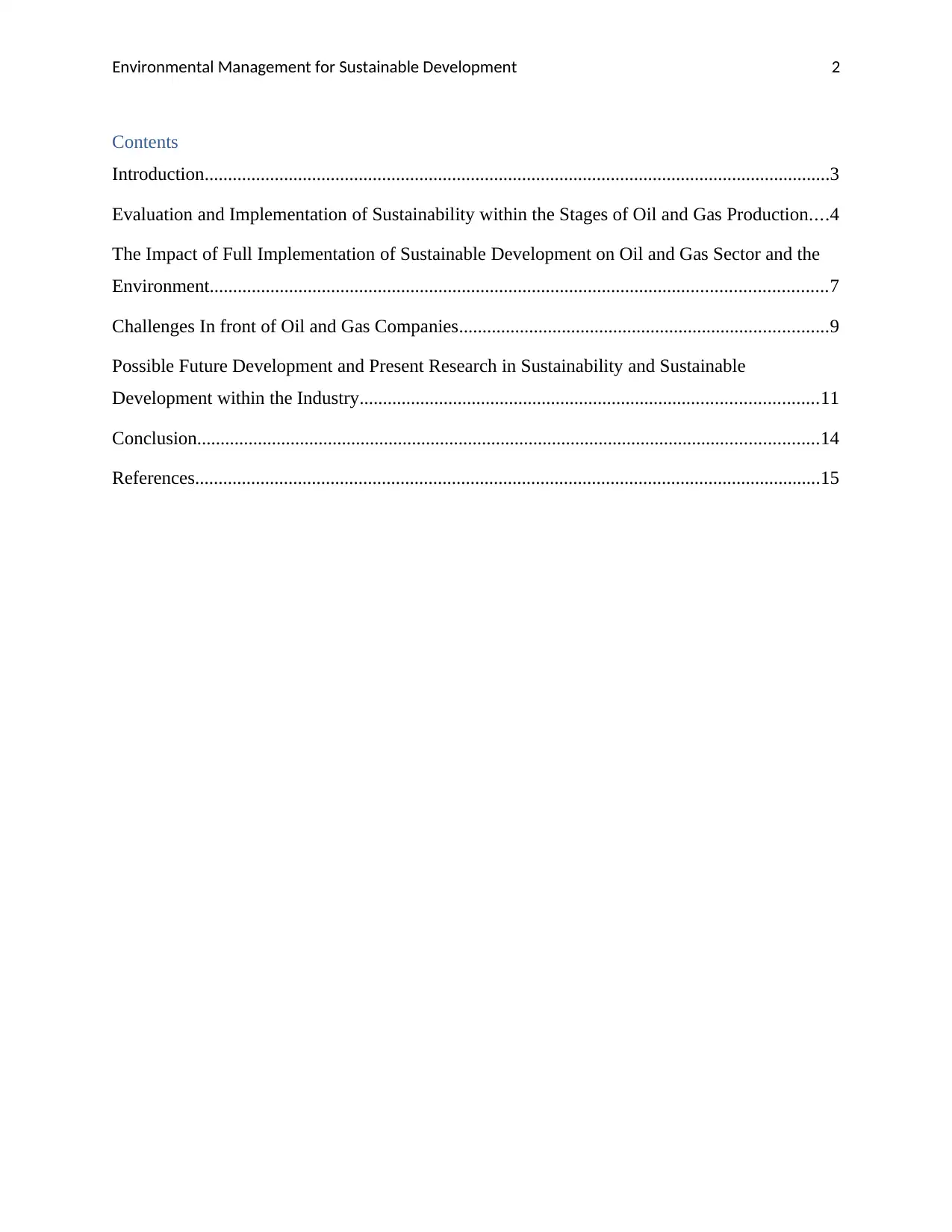
Environmental Management for Sustainable Development 2
Contents
Introduction......................................................................................................................................3
Evaluation and Implementation of Sustainability within the Stages of Oil and Gas Production....4
The Impact of Full Implementation of Sustainable Development on Oil and Gas Sector and the
Environment....................................................................................................................................7
Challenges In front of Oil and Gas Companies...............................................................................9
Possible Future Development and Present Research in Sustainability and Sustainable
Development within the Industry..................................................................................................11
Conclusion.....................................................................................................................................14
References......................................................................................................................................15
Contents
Introduction......................................................................................................................................3
Evaluation and Implementation of Sustainability within the Stages of Oil and Gas Production....4
The Impact of Full Implementation of Sustainable Development on Oil and Gas Sector and the
Environment....................................................................................................................................7
Challenges In front of Oil and Gas Companies...............................................................................9
Possible Future Development and Present Research in Sustainability and Sustainable
Development within the Industry..................................................................................................11
Conclusion.....................................................................................................................................14
References......................................................................................................................................15
⊘ This is a preview!⊘
Do you want full access?
Subscribe today to unlock all pages.

Trusted by 1+ million students worldwide
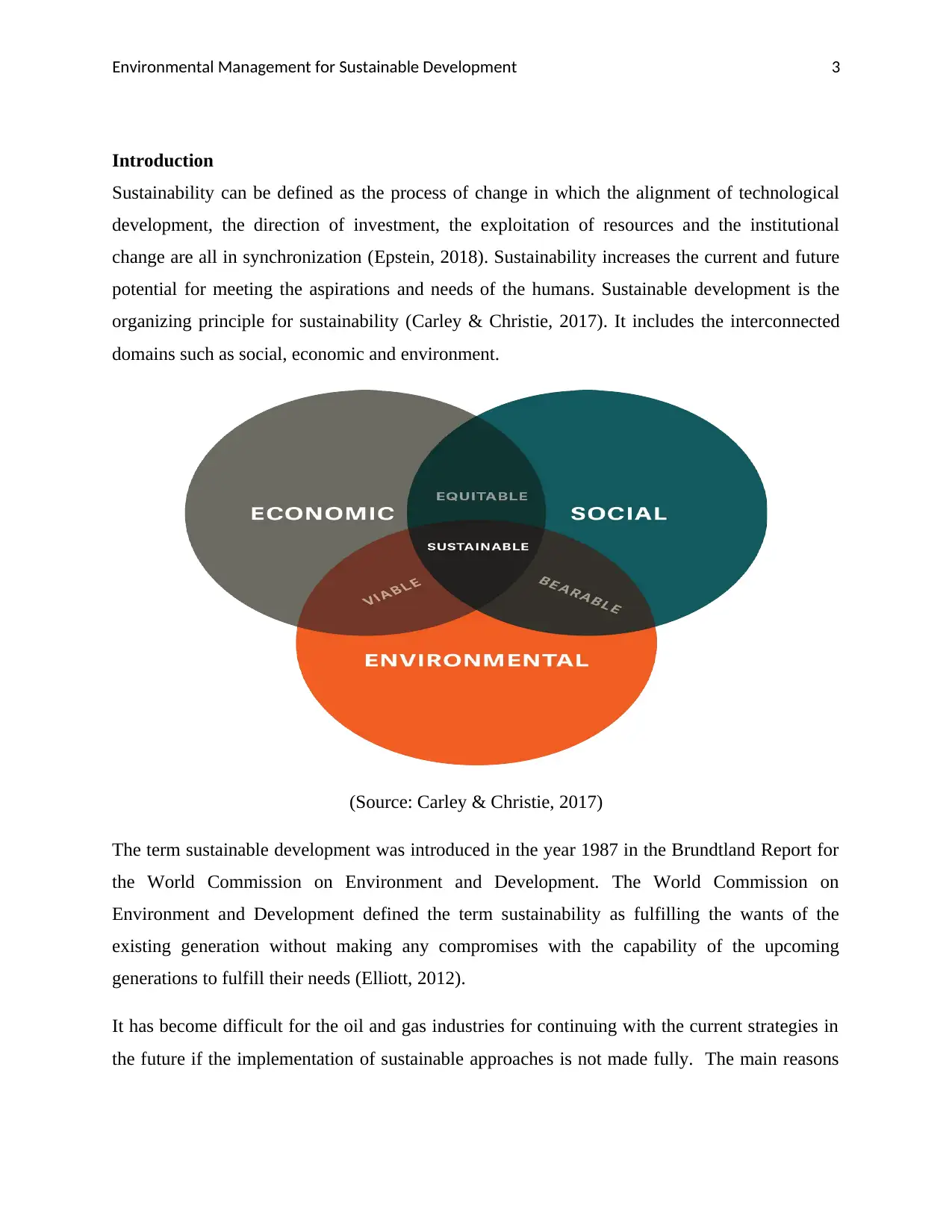
Environmental Management for Sustainable Development 3
Introduction
Sustainability can be defined as the process of change in which the alignment of technological
development, the direction of investment, the exploitation of resources and the institutional
change are all in synchronization (Epstein, 2018). Sustainability increases the current and future
potential for meeting the aspirations and needs of the humans. Sustainable development is the
organizing principle for sustainability (Carley & Christie, 2017). It includes the interconnected
domains such as social, economic and environment.
(Source: Carley & Christie, 2017)
The term sustainable development was introduced in the year 1987 in the Brundtland Report for
the World Commission on Environment and Development. The World Commission on
Environment and Development defined the term sustainability as fulfilling the wants of the
existing generation without making any compromises with the capability of the upcoming
generations to fulfill their needs (Elliott, 2012).
It has become difficult for the oil and gas industries for continuing with the current strategies in
the future if the implementation of sustainable approaches is not made fully. The main reasons
Introduction
Sustainability can be defined as the process of change in which the alignment of technological
development, the direction of investment, the exploitation of resources and the institutional
change are all in synchronization (Epstein, 2018). Sustainability increases the current and future
potential for meeting the aspirations and needs of the humans. Sustainable development is the
organizing principle for sustainability (Carley & Christie, 2017). It includes the interconnected
domains such as social, economic and environment.
(Source: Carley & Christie, 2017)
The term sustainable development was introduced in the year 1987 in the Brundtland Report for
the World Commission on Environment and Development. The World Commission on
Environment and Development defined the term sustainability as fulfilling the wants of the
existing generation without making any compromises with the capability of the upcoming
generations to fulfill their needs (Elliott, 2012).
It has become difficult for the oil and gas industries for continuing with the current strategies in
the future if the implementation of sustainable approaches is not made fully. The main reasons
Paraphrase This Document
Need a fresh take? Get an instant paraphrase of this document with our AI Paraphraser
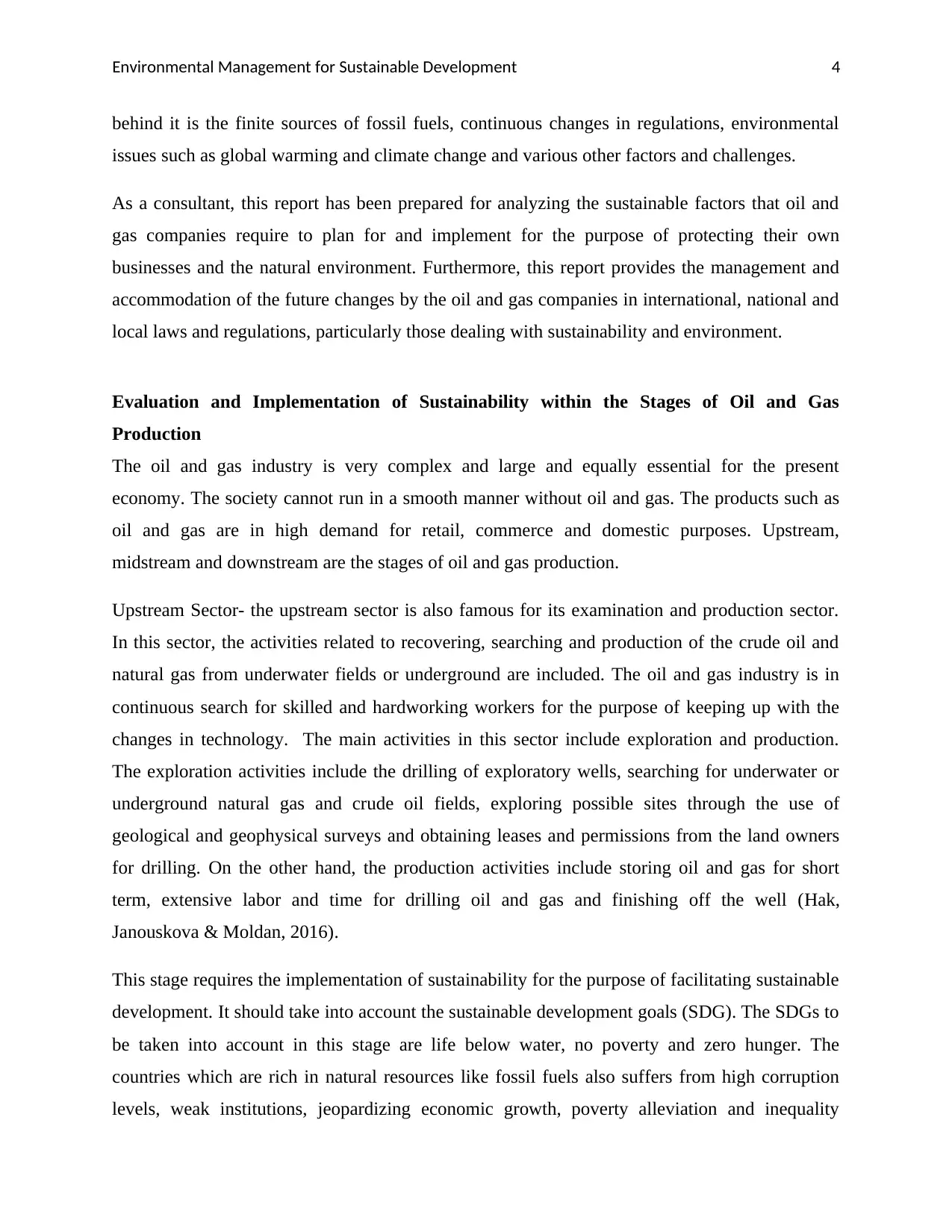
Environmental Management for Sustainable Development 4
behind it is the finite sources of fossil fuels, continuous changes in regulations, environmental
issues such as global warming and climate change and various other factors and challenges.
As a consultant, this report has been prepared for analyzing the sustainable factors that oil and
gas companies require to plan for and implement for the purpose of protecting their own
businesses and the natural environment. Furthermore, this report provides the management and
accommodation of the future changes by the oil and gas companies in international, national and
local laws and regulations, particularly those dealing with sustainability and environment.
Evaluation and Implementation of Sustainability within the Stages of Oil and Gas
Production
The oil and gas industry is very complex and large and equally essential for the present
economy. The society cannot run in a smooth manner without oil and gas. The products such as
oil and gas are in high demand for retail, commerce and domestic purposes. Upstream,
midstream and downstream are the stages of oil and gas production.
Upstream Sector- the upstream sector is also famous for its examination and production sector.
In this sector, the activities related to recovering, searching and production of the crude oil and
natural gas from underwater fields or underground are included. The oil and gas industry is in
continuous search for skilled and hardworking workers for the purpose of keeping up with the
changes in technology. The main activities in this sector include exploration and production.
The exploration activities include the drilling of exploratory wells, searching for underwater or
underground natural gas and crude oil fields, exploring possible sites through the use of
geological and geophysical surveys and obtaining leases and permissions from the land owners
for drilling. On the other hand, the production activities include storing oil and gas for short
term, extensive labor and time for drilling oil and gas and finishing off the well (Hak,
Janouskova & Moldan, 2016).
This stage requires the implementation of sustainability for the purpose of facilitating sustainable
development. It should take into account the sustainable development goals (SDG). The SDGs to
be taken into account in this stage are life below water, no poverty and zero hunger. The
countries which are rich in natural resources like fossil fuels also suffers from high corruption
levels, weak institutions, jeopardizing economic growth, poverty alleviation and inequality
behind it is the finite sources of fossil fuels, continuous changes in regulations, environmental
issues such as global warming and climate change and various other factors and challenges.
As a consultant, this report has been prepared for analyzing the sustainable factors that oil and
gas companies require to plan for and implement for the purpose of protecting their own
businesses and the natural environment. Furthermore, this report provides the management and
accommodation of the future changes by the oil and gas companies in international, national and
local laws and regulations, particularly those dealing with sustainability and environment.
Evaluation and Implementation of Sustainability within the Stages of Oil and Gas
Production
The oil and gas industry is very complex and large and equally essential for the present
economy. The society cannot run in a smooth manner without oil and gas. The products such as
oil and gas are in high demand for retail, commerce and domestic purposes. Upstream,
midstream and downstream are the stages of oil and gas production.
Upstream Sector- the upstream sector is also famous for its examination and production sector.
In this sector, the activities related to recovering, searching and production of the crude oil and
natural gas from underwater fields or underground are included. The oil and gas industry is in
continuous search for skilled and hardworking workers for the purpose of keeping up with the
changes in technology. The main activities in this sector include exploration and production.
The exploration activities include the drilling of exploratory wells, searching for underwater or
underground natural gas and crude oil fields, exploring possible sites through the use of
geological and geophysical surveys and obtaining leases and permissions from the land owners
for drilling. On the other hand, the production activities include storing oil and gas for short
term, extensive labor and time for drilling oil and gas and finishing off the well (Hak,
Janouskova & Moldan, 2016).
This stage requires the implementation of sustainability for the purpose of facilitating sustainable
development. It should take into account the sustainable development goals (SDG). The SDGs to
be taken into account in this stage are life below water, no poverty and zero hunger. The
countries which are rich in natural resources like fossil fuels also suffers from high corruption
levels, weak institutions, jeopardizing economic growth, poverty alleviation and inequality
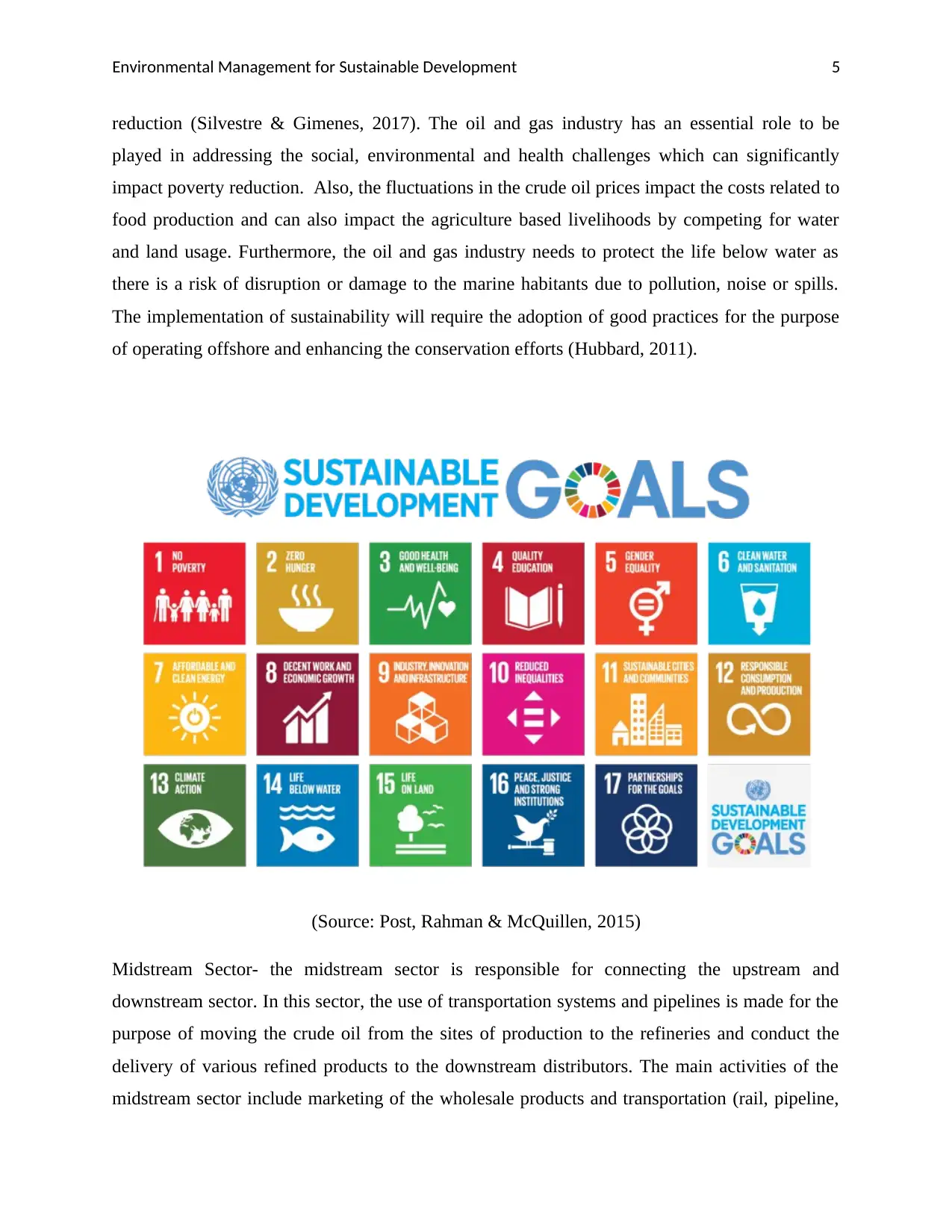
Environmental Management for Sustainable Development 5
reduction (Silvestre & Gimenes, 2017). The oil and gas industry has an essential role to be
played in addressing the social, environmental and health challenges which can significantly
impact poverty reduction. Also, the fluctuations in the crude oil prices impact the costs related to
food production and can also impact the agriculture based livelihoods by competing for water
and land usage. Furthermore, the oil and gas industry needs to protect the life below water as
there is a risk of disruption or damage to the marine habitants due to pollution, noise or spills.
The implementation of sustainability will require the adoption of good practices for the purpose
of operating offshore and enhancing the conservation efforts (Hubbard, 2011).
(Source: Post, Rahman & McQuillen, 2015)
Midstream Sector- the midstream sector is responsible for connecting the upstream and
downstream sector. In this sector, the use of transportation systems and pipelines is made for the
purpose of moving the crude oil from the sites of production to the refineries and conduct the
delivery of various refined products to the downstream distributors. The main activities of the
midstream sector include marketing of the wholesale products and transportation (rail, pipeline,
reduction (Silvestre & Gimenes, 2017). The oil and gas industry has an essential role to be
played in addressing the social, environmental and health challenges which can significantly
impact poverty reduction. Also, the fluctuations in the crude oil prices impact the costs related to
food production and can also impact the agriculture based livelihoods by competing for water
and land usage. Furthermore, the oil and gas industry needs to protect the life below water as
there is a risk of disruption or damage to the marine habitants due to pollution, noise or spills.
The implementation of sustainability will require the adoption of good practices for the purpose
of operating offshore and enhancing the conservation efforts (Hubbard, 2011).
(Source: Post, Rahman & McQuillen, 2015)
Midstream Sector- the midstream sector is responsible for connecting the upstream and
downstream sector. In this sector, the use of transportation systems and pipelines is made for the
purpose of moving the crude oil from the sites of production to the refineries and conduct the
delivery of various refined products to the downstream distributors. The main activities of the
midstream sector include marketing of the wholesale products and transportation (rail, pipeline,
⊘ This is a preview!⊘
Do you want full access?
Subscribe today to unlock all pages.

Trusted by 1+ million students worldwide
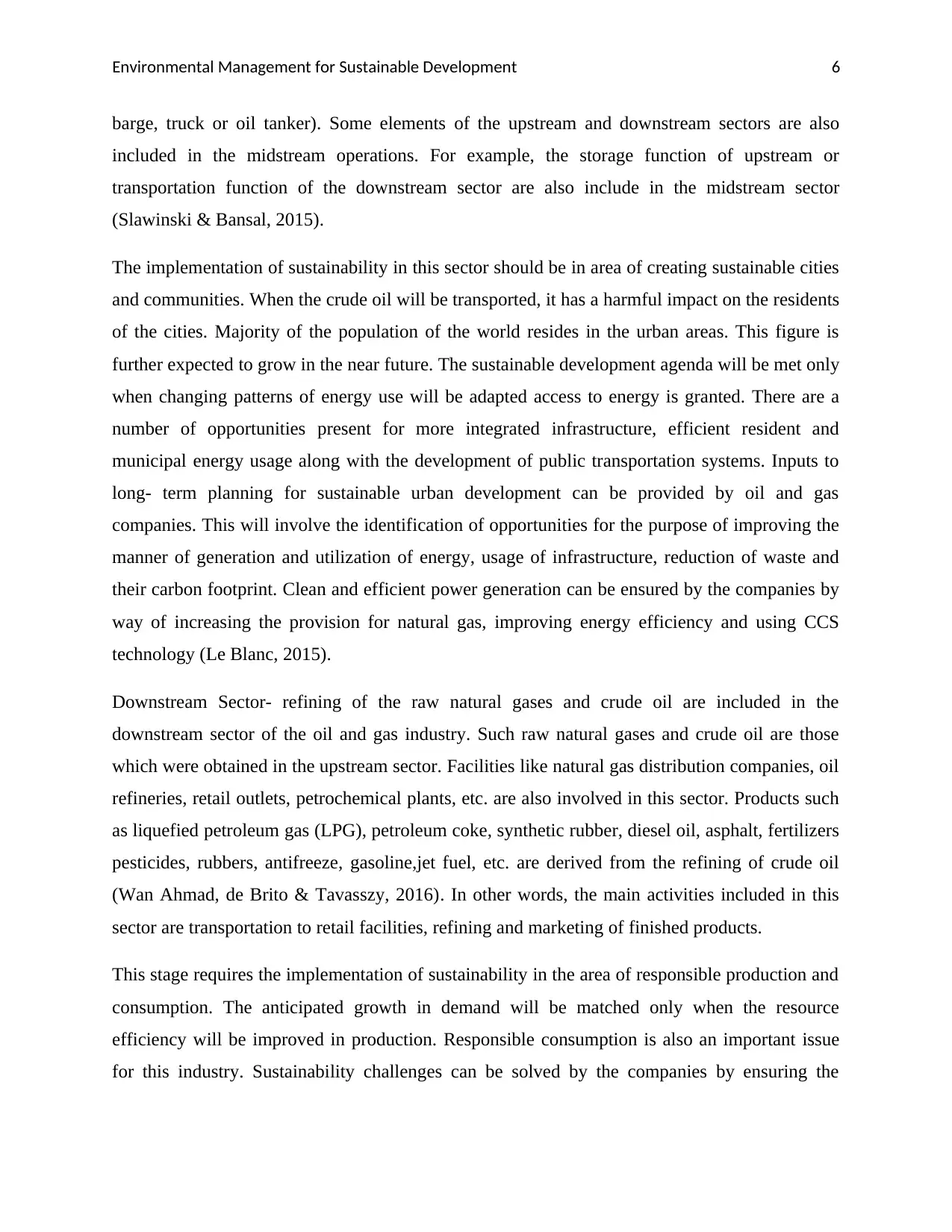
Environmental Management for Sustainable Development 6
barge, truck or oil tanker). Some elements of the upstream and downstream sectors are also
included in the midstream operations. For example, the storage function of upstream or
transportation function of the downstream sector are also include in the midstream sector
(Slawinski & Bansal, 2015).
The implementation of sustainability in this sector should be in area of creating sustainable cities
and communities. When the crude oil will be transported, it has a harmful impact on the residents
of the cities. Majority of the population of the world resides in the urban areas. This figure is
further expected to grow in the near future. The sustainable development agenda will be met only
when changing patterns of energy use will be adapted access to energy is granted. There are a
number of opportunities present for more integrated infrastructure, efficient resident and
municipal energy usage along with the development of public transportation systems. Inputs to
long- term planning for sustainable urban development can be provided by oil and gas
companies. This will involve the identification of opportunities for the purpose of improving the
manner of generation and utilization of energy, usage of infrastructure, reduction of waste and
their carbon footprint. Clean and efficient power generation can be ensured by the companies by
way of increasing the provision for natural gas, improving energy efficiency and using CCS
technology (Le Blanc, 2015).
Downstream Sector- refining of the raw natural gases and crude oil are included in the
downstream sector of the oil and gas industry. Such raw natural gases and crude oil are those
which were obtained in the upstream sector. Facilities like natural gas distribution companies, oil
refineries, retail outlets, petrochemical plants, etc. are also involved in this sector. Products such
as liquefied petroleum gas (LPG), petroleum coke, synthetic rubber, diesel oil, asphalt, fertilizers
pesticides, rubbers, antifreeze, gasoline,jet fuel, etc. are derived from the refining of crude oil
(Wan Ahmad, de Brito & Tavasszy, 2016). In other words, the main activities included in this
sector are transportation to retail facilities, refining and marketing of finished products.
This stage requires the implementation of sustainability in the area of responsible production and
consumption. The anticipated growth in demand will be matched only when the resource
efficiency will be improved in production. Responsible consumption is also an important issue
for this industry. Sustainability challenges can be solved by the companies by ensuring the
barge, truck or oil tanker). Some elements of the upstream and downstream sectors are also
included in the midstream operations. For example, the storage function of upstream or
transportation function of the downstream sector are also include in the midstream sector
(Slawinski & Bansal, 2015).
The implementation of sustainability in this sector should be in area of creating sustainable cities
and communities. When the crude oil will be transported, it has a harmful impact on the residents
of the cities. Majority of the population of the world resides in the urban areas. This figure is
further expected to grow in the near future. The sustainable development agenda will be met only
when changing patterns of energy use will be adapted access to energy is granted. There are a
number of opportunities present for more integrated infrastructure, efficient resident and
municipal energy usage along with the development of public transportation systems. Inputs to
long- term planning for sustainable urban development can be provided by oil and gas
companies. This will involve the identification of opportunities for the purpose of improving the
manner of generation and utilization of energy, usage of infrastructure, reduction of waste and
their carbon footprint. Clean and efficient power generation can be ensured by the companies by
way of increasing the provision for natural gas, improving energy efficiency and using CCS
technology (Le Blanc, 2015).
Downstream Sector- refining of the raw natural gases and crude oil are included in the
downstream sector of the oil and gas industry. Such raw natural gases and crude oil are those
which were obtained in the upstream sector. Facilities like natural gas distribution companies, oil
refineries, retail outlets, petrochemical plants, etc. are also involved in this sector. Products such
as liquefied petroleum gas (LPG), petroleum coke, synthetic rubber, diesel oil, asphalt, fertilizers
pesticides, rubbers, antifreeze, gasoline,jet fuel, etc. are derived from the refining of crude oil
(Wan Ahmad, de Brito & Tavasszy, 2016). In other words, the main activities included in this
sector are transportation to retail facilities, refining and marketing of finished products.
This stage requires the implementation of sustainability in the area of responsible production and
consumption. The anticipated growth in demand will be matched only when the resource
efficiency will be improved in production. Responsible consumption is also an important issue
for this industry. Sustainability challenges can be solved by the companies by ensuring the
Paraphrase This Document
Need a fresh take? Get an instant paraphrase of this document with our AI Paraphraser
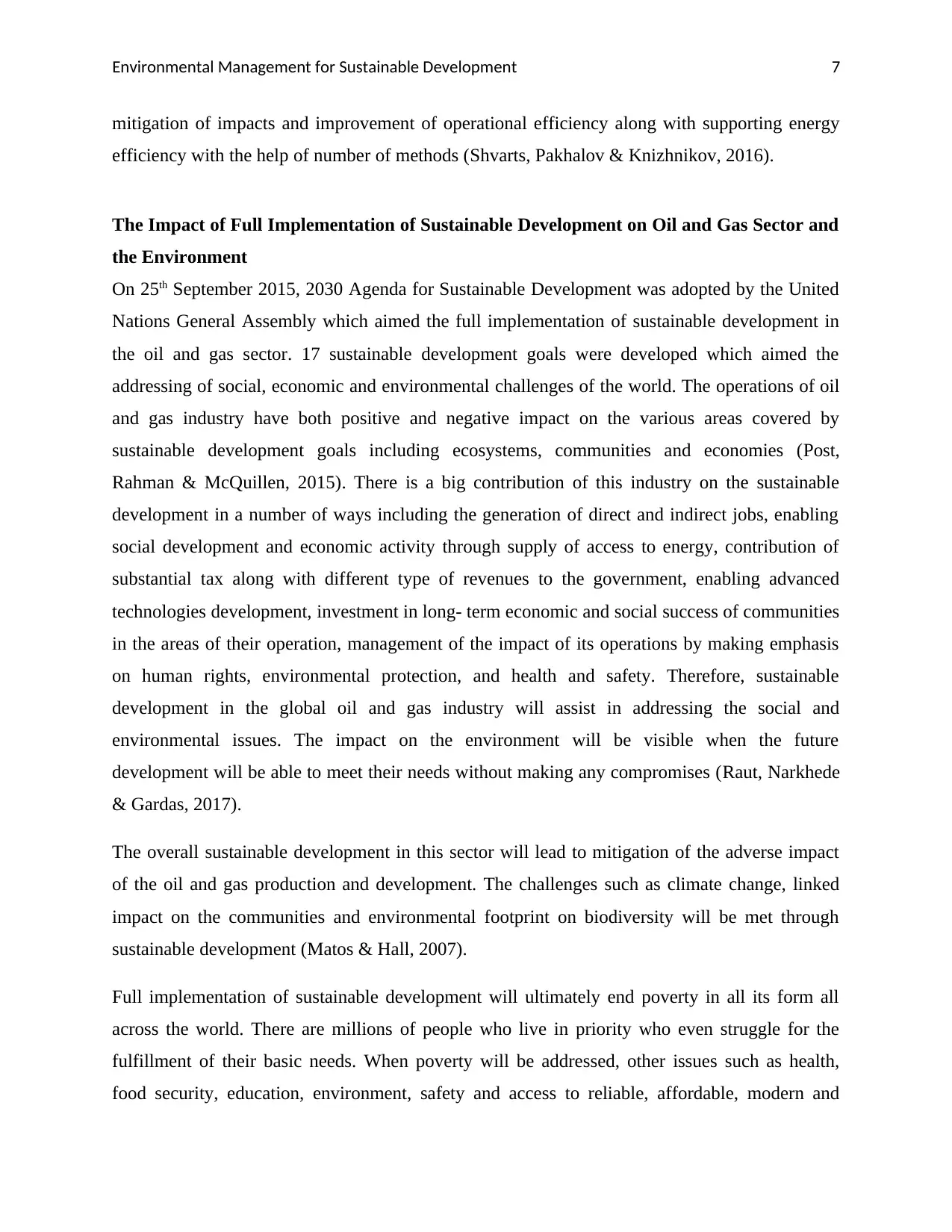
Environmental Management for Sustainable Development 7
mitigation of impacts and improvement of operational efficiency along with supporting energy
efficiency with the help of number of methods (Shvarts, Pakhalov & Knizhnikov, 2016).
The Impact of Full Implementation of Sustainable Development on Oil and Gas Sector and
the Environment
On 25th September 2015, 2030 Agenda for Sustainable Development was adopted by the United
Nations General Assembly which aimed the full implementation of sustainable development in
the oil and gas sector. 17 sustainable development goals were developed which aimed the
addressing of social, economic and environmental challenges of the world. The operations of oil
and gas industry have both positive and negative impact on the various areas covered by
sustainable development goals including ecosystems, communities and economies (Post,
Rahman & McQuillen, 2015). There is a big contribution of this industry on the sustainable
development in a number of ways including the generation of direct and indirect jobs, enabling
social development and economic activity through supply of access to energy, contribution of
substantial tax along with different type of revenues to the government, enabling advanced
technologies development, investment in long- term economic and social success of communities
in the areas of their operation, management of the impact of its operations by making emphasis
on human rights, environmental protection, and health and safety. Therefore, sustainable
development in the global oil and gas industry will assist in addressing the social and
environmental issues. The impact on the environment will be visible when the future
development will be able to meet their needs without making any compromises (Raut, Narkhede
& Gardas, 2017).
The overall sustainable development in this sector will lead to mitigation of the adverse impact
of the oil and gas production and development. The challenges such as climate change, linked
impact on the communities and environmental footprint on biodiversity will be met through
sustainable development (Matos & Hall, 2007).
Full implementation of sustainable development will ultimately end poverty in all its form all
across the world. There are millions of people who live in priority who even struggle for the
fulfillment of their basic needs. When poverty will be addressed, other issues such as health,
food security, education, environment, safety and access to reliable, affordable, modern and
mitigation of impacts and improvement of operational efficiency along with supporting energy
efficiency with the help of number of methods (Shvarts, Pakhalov & Knizhnikov, 2016).
The Impact of Full Implementation of Sustainable Development on Oil and Gas Sector and
the Environment
On 25th September 2015, 2030 Agenda for Sustainable Development was adopted by the United
Nations General Assembly which aimed the full implementation of sustainable development in
the oil and gas sector. 17 sustainable development goals were developed which aimed the
addressing of social, economic and environmental challenges of the world. The operations of oil
and gas industry have both positive and negative impact on the various areas covered by
sustainable development goals including ecosystems, communities and economies (Post,
Rahman & McQuillen, 2015). There is a big contribution of this industry on the sustainable
development in a number of ways including the generation of direct and indirect jobs, enabling
social development and economic activity through supply of access to energy, contribution of
substantial tax along with different type of revenues to the government, enabling advanced
technologies development, investment in long- term economic and social success of communities
in the areas of their operation, management of the impact of its operations by making emphasis
on human rights, environmental protection, and health and safety. Therefore, sustainable
development in the global oil and gas industry will assist in addressing the social and
environmental issues. The impact on the environment will be visible when the future
development will be able to meet their needs without making any compromises (Raut, Narkhede
& Gardas, 2017).
The overall sustainable development in this sector will lead to mitigation of the adverse impact
of the oil and gas production and development. The challenges such as climate change, linked
impact on the communities and environmental footprint on biodiversity will be met through
sustainable development (Matos & Hall, 2007).
Full implementation of sustainable development will ultimately end poverty in all its form all
across the world. There are millions of people who live in priority who even struggle for the
fulfillment of their basic needs. When poverty will be addressed, other issues such as health,
food security, education, environment, safety and access to reliable, affordable, modern and

Environmental Management for Sustainable Development 8
sustainable energy sources will also be addressed. Furthermore, the industry is also capable of
addressing a number of challenges related to the environment, society and health which can
significantly impact the poverty reduction (Roca & Searcy, 2012).
When sustainable development will be ensured in the oil and gas industry, its harmful impacts
such as pollution will be minimized which is caused by the oil and gas activities. Gas emissions,
wastewaters, aerosols and solid waste which are generated during the process of refining, drilling
and transportation will also be minimized leading to positive impact on the environment. This
will further control other harmful effects such acid rain, greenhouse effect, water contamination
and drop in water quality.
The implementation of sustainable development will have a positive impact on the oil and gas
sector. Poverty and hunger will be ended and the industry will get hardworking workers who are
ready to make their best possible efforts for the achievement of the targets of their companies.
Furthermore, energy efficiency will be improved in the areas of operation and production. Also,
the share of natural gas will be increased in the energy mix along with the improvement in access
to energy services with the help of shared infrastructure (Waas, et.al., 2014). In this way, access
to reliable, affordable and modern energy will also be ensured for all the people. Through the
reduction of inequalities among and within countries, local governance will be improved and the
revenue management will be enhanced. When this practice will be integrated into the core
business of oil and gas companies, they will be able to ensure transparent and full tax payments,
assess the impacts of inequalities in project planning, mitigation of the climate change impacts,
providing access to energy and setting expectations and communications with the communities
in the localities (La Macchia, Hall, Wasserman & Zotes, 2017).
Sustainability in the oil and gas sector will make human settlements and cities, resilient, safe,
inclusive and sustainable. In this way, the industry will be capable of protecting ad safeguarding
the natural and cultural heritage of the world. Also, it will be able to address the risks associated
with the operations in the urban environment. Sustainable and inclusive urbanization will be
supported in the communities which are situated near the areas of operations. When the industry
will take urgent action for the purpose of combating climate change along with its impacts, it
will be able to plan strategically for a future where the industry makes zero emissions. Also, the
sustainable energy sources will also be addressed. Furthermore, the industry is also capable of
addressing a number of challenges related to the environment, society and health which can
significantly impact the poverty reduction (Roca & Searcy, 2012).
When sustainable development will be ensured in the oil and gas industry, its harmful impacts
such as pollution will be minimized which is caused by the oil and gas activities. Gas emissions,
wastewaters, aerosols and solid waste which are generated during the process of refining, drilling
and transportation will also be minimized leading to positive impact on the environment. This
will further control other harmful effects such acid rain, greenhouse effect, water contamination
and drop in water quality.
The implementation of sustainable development will have a positive impact on the oil and gas
sector. Poverty and hunger will be ended and the industry will get hardworking workers who are
ready to make their best possible efforts for the achievement of the targets of their companies.
Furthermore, energy efficiency will be improved in the areas of operation and production. Also,
the share of natural gas will be increased in the energy mix along with the improvement in access
to energy services with the help of shared infrastructure (Waas, et.al., 2014). In this way, access
to reliable, affordable and modern energy will also be ensured for all the people. Through the
reduction of inequalities among and within countries, local governance will be improved and the
revenue management will be enhanced. When this practice will be integrated into the core
business of oil and gas companies, they will be able to ensure transparent and full tax payments,
assess the impacts of inequalities in project planning, mitigation of the climate change impacts,
providing access to energy and setting expectations and communications with the communities
in the localities (La Macchia, Hall, Wasserman & Zotes, 2017).
Sustainability in the oil and gas sector will make human settlements and cities, resilient, safe,
inclusive and sustainable. In this way, the industry will be capable of protecting ad safeguarding
the natural and cultural heritage of the world. Also, it will be able to address the risks associated
with the operations in the urban environment. Sustainable and inclusive urbanization will be
supported in the communities which are situated near the areas of operations. When the industry
will take urgent action for the purpose of combating climate change along with its impacts, it
will be able to plan strategically for a future where the industry makes zero emissions. Also, the
⊘ This is a preview!⊘
Do you want full access?
Subscribe today to unlock all pages.

Trusted by 1+ million students worldwide
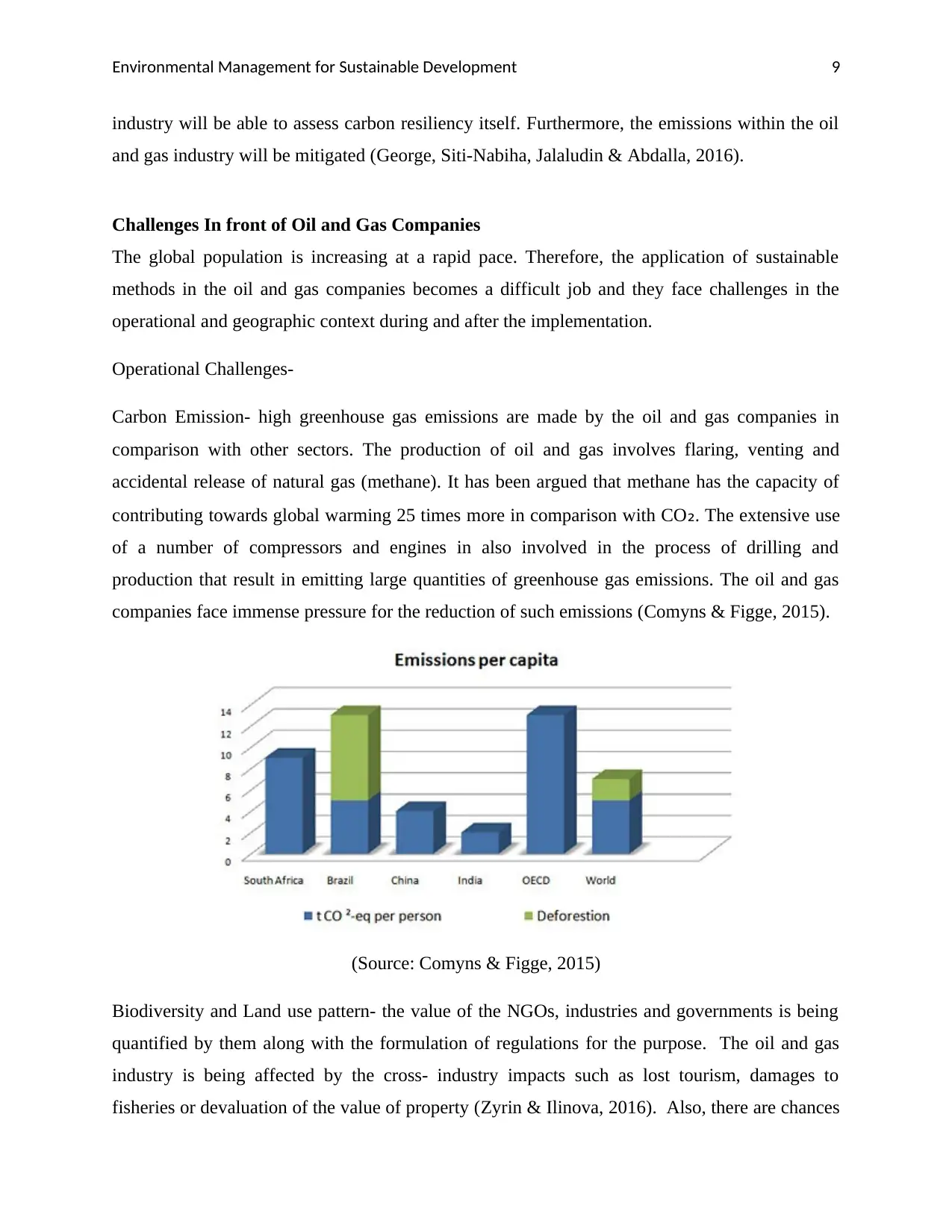
Environmental Management for Sustainable Development 9
industry will be able to assess carbon resiliency itself. Furthermore, the emissions within the oil
and gas industry will be mitigated (George, Siti-Nabiha, Jalaludin & Abdalla, 2016).
Challenges In front of Oil and Gas Companies
The global population is increasing at a rapid pace. Therefore, the application of sustainable
methods in the oil and gas companies becomes a difficult job and they face challenges in the
operational and geographic context during and after the implementation.
Operational Challenges-
Carbon Emission- high greenhouse gas emissions are made by the oil and gas companies in
comparison with other sectors. The production of oil and gas involves flaring, venting and
accidental release of natural gas (methane). It has been argued that methane has the capacity of
contributing towards global warming 25 times more in comparison with CO₂. The extensive use
of a number of compressors and engines in also involved in the process of drilling and
production that result in emitting large quantities of greenhouse gas emissions. The oil and gas
companies face immense pressure for the reduction of such emissions (Comyns & Figge, 2015).
(Source: Comyns & Figge, 2015)
Biodiversity and Land use pattern- the value of the NGOs, industries and governments is being
quantified by them along with the formulation of regulations for the purpose. The oil and gas
industry is being affected by the cross- industry impacts such as lost tourism, damages to
fisheries or devaluation of the value of property (Zyrin & Ilinova, 2016). Also, there are chances
industry will be able to assess carbon resiliency itself. Furthermore, the emissions within the oil
and gas industry will be mitigated (George, Siti-Nabiha, Jalaludin & Abdalla, 2016).
Challenges In front of Oil and Gas Companies
The global population is increasing at a rapid pace. Therefore, the application of sustainable
methods in the oil and gas companies becomes a difficult job and they face challenges in the
operational and geographic context during and after the implementation.
Operational Challenges-
Carbon Emission- high greenhouse gas emissions are made by the oil and gas companies in
comparison with other sectors. The production of oil and gas involves flaring, venting and
accidental release of natural gas (methane). It has been argued that methane has the capacity of
contributing towards global warming 25 times more in comparison with CO₂. The extensive use
of a number of compressors and engines in also involved in the process of drilling and
production that result in emitting large quantities of greenhouse gas emissions. The oil and gas
companies face immense pressure for the reduction of such emissions (Comyns & Figge, 2015).
(Source: Comyns & Figge, 2015)
Biodiversity and Land use pattern- the value of the NGOs, industries and governments is being
quantified by them along with the formulation of regulations for the purpose. The oil and gas
industry is being affected by the cross- industry impacts such as lost tourism, damages to
fisheries or devaluation of the value of property (Zyrin & Ilinova, 2016). Also, there are chances
Paraphrase This Document
Need a fresh take? Get an instant paraphrase of this document with our AI Paraphraser
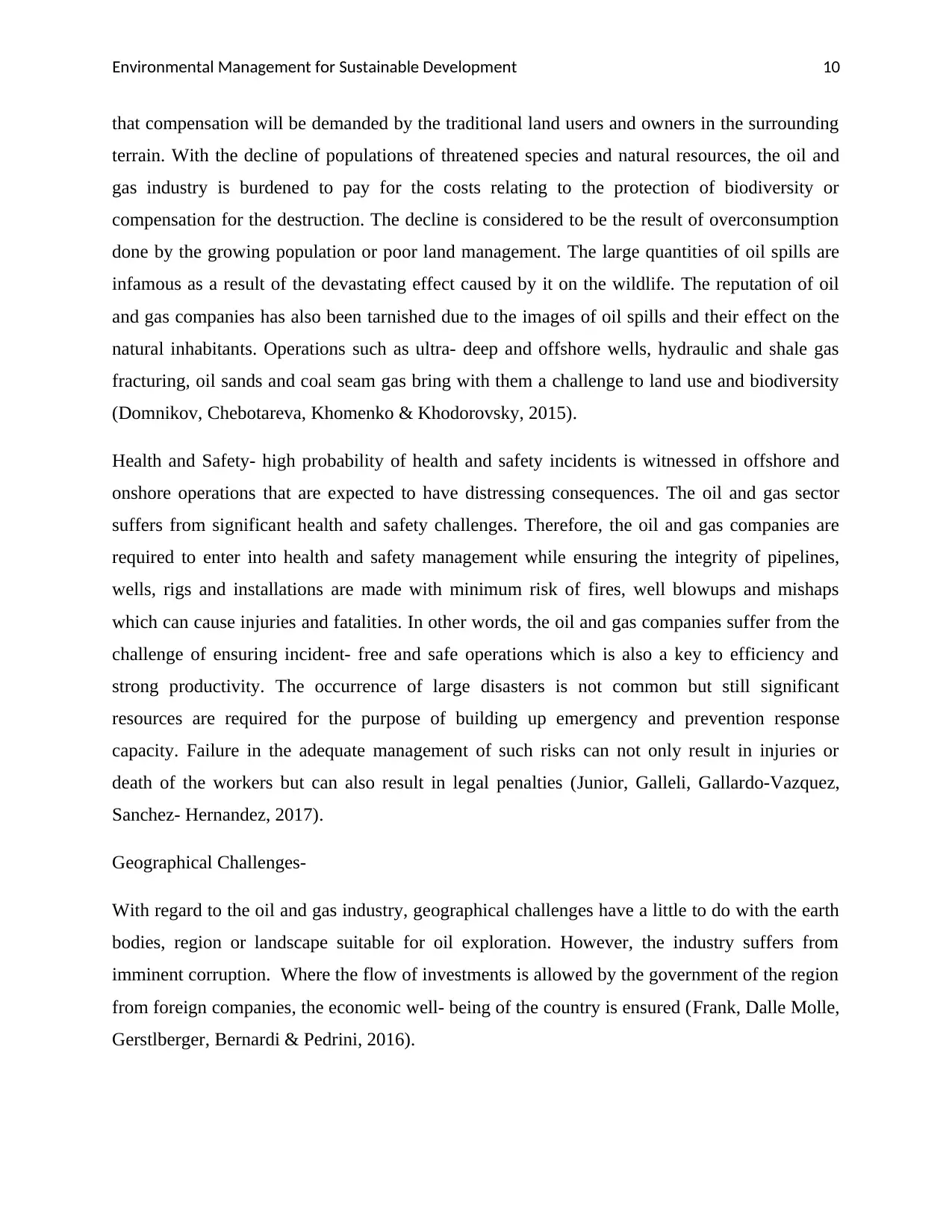
Environmental Management for Sustainable Development 10
that compensation will be demanded by the traditional land users and owners in the surrounding
terrain. With the decline of populations of threatened species and natural resources, the oil and
gas industry is burdened to pay for the costs relating to the protection of biodiversity or
compensation for the destruction. The decline is considered to be the result of overconsumption
done by the growing population or poor land management. The large quantities of oil spills are
infamous as a result of the devastating effect caused by it on the wildlife. The reputation of oil
and gas companies has also been tarnished due to the images of oil spills and their effect on the
natural inhabitants. Operations such as ultra- deep and offshore wells, hydraulic and shale gas
fracturing, oil sands and coal seam gas bring with them a challenge to land use and biodiversity
(Domnikov, Chebotareva, Khomenko & Khodorovsky, 2015).
Health and Safety- high probability of health and safety incidents is witnessed in offshore and
onshore operations that are expected to have distressing consequences. The oil and gas sector
suffers from significant health and safety challenges. Therefore, the oil and gas companies are
required to enter into health and safety management while ensuring the integrity of pipelines,
wells, rigs and installations are made with minimum risk of fires, well blowups and mishaps
which can cause injuries and fatalities. In other words, the oil and gas companies suffer from the
challenge of ensuring incident- free and safe operations which is also a key to efficiency and
strong productivity. The occurrence of large disasters is not common but still significant
resources are required for the purpose of building up emergency and prevention response
capacity. Failure in the adequate management of such risks can not only result in injuries or
death of the workers but can also result in legal penalties (Junior, Galleli, Gallardo-Vazquez,
Sanchez- Hernandez, 2017).
Geographical Challenges-
With regard to the oil and gas industry, geographical challenges have a little to do with the earth
bodies, region or landscape suitable for oil exploration. However, the industry suffers from
imminent corruption. Where the flow of investments is allowed by the government of the region
from foreign companies, the economic well- being of the country is ensured (Frank, Dalle Molle,
Gerstlberger, Bernardi & Pedrini, 2016).
that compensation will be demanded by the traditional land users and owners in the surrounding
terrain. With the decline of populations of threatened species and natural resources, the oil and
gas industry is burdened to pay for the costs relating to the protection of biodiversity or
compensation for the destruction. The decline is considered to be the result of overconsumption
done by the growing population or poor land management. The large quantities of oil spills are
infamous as a result of the devastating effect caused by it on the wildlife. The reputation of oil
and gas companies has also been tarnished due to the images of oil spills and their effect on the
natural inhabitants. Operations such as ultra- deep and offshore wells, hydraulic and shale gas
fracturing, oil sands and coal seam gas bring with them a challenge to land use and biodiversity
(Domnikov, Chebotareva, Khomenko & Khodorovsky, 2015).
Health and Safety- high probability of health and safety incidents is witnessed in offshore and
onshore operations that are expected to have distressing consequences. The oil and gas sector
suffers from significant health and safety challenges. Therefore, the oil and gas companies are
required to enter into health and safety management while ensuring the integrity of pipelines,
wells, rigs and installations are made with minimum risk of fires, well blowups and mishaps
which can cause injuries and fatalities. In other words, the oil and gas companies suffer from the
challenge of ensuring incident- free and safe operations which is also a key to efficiency and
strong productivity. The occurrence of large disasters is not common but still significant
resources are required for the purpose of building up emergency and prevention response
capacity. Failure in the adequate management of such risks can not only result in injuries or
death of the workers but can also result in legal penalties (Junior, Galleli, Gallardo-Vazquez,
Sanchez- Hernandez, 2017).
Geographical Challenges-
With regard to the oil and gas industry, geographical challenges have a little to do with the earth
bodies, region or landscape suitable for oil exploration. However, the industry suffers from
imminent corruption. Where the flow of investments is allowed by the government of the region
from foreign companies, the economic well- being of the country is ensured (Frank, Dalle Molle,
Gerstlberger, Bernardi & Pedrini, 2016).

Environmental Management for Sustainable Development 11
Corruption in Oil and Gas Industry- the hunt for oil sources is often conducted in areas facing
violence, political instability and corrupt business practices. Strong opportunities for growth are
offered by such regions. However, the stock prices for the company can suffer from devaluation
due to the discomfort felt by the investors due to the regional political instability. This is due to
the fact that turbulent situations can result in spill over and disrupt operations. Payouts can be
demanded by the political regimes which are considered to be illegal in a number of countries.
There is increasing number of fines due to the violation of these laws (Omer, 2008). The oil and
gas industry lacks transparency. There is secrecy in terms of publishing of revenues and
payments made to the government for exploitation of resources. Unlawful benefits are reaped by
the industry insiders and politicians. Majority of the oil and gas companies are sate owned. Also,
the emerging markets are governmental which leads to having touch points with the government.
This further leads to the practice of demanding bribes. Identities of the equity holders and
subsidiaries are also protected by the oil and gas companies which make it easy for the
corruption leaders to effectively hide the stolen funds. Therefore, it becomes a challenge for the
oil and gas sector to hold the government accountable for these acts without any published
information and proof of hidden taxes and royalties (Frynas, 2005).
(Source: Berkowitz, Bucheli & Dumez, 2017)
Corruption in Oil and Gas Industry- the hunt for oil sources is often conducted in areas facing
violence, political instability and corrupt business practices. Strong opportunities for growth are
offered by such regions. However, the stock prices for the company can suffer from devaluation
due to the discomfort felt by the investors due to the regional political instability. This is due to
the fact that turbulent situations can result in spill over and disrupt operations. Payouts can be
demanded by the political regimes which are considered to be illegal in a number of countries.
There is increasing number of fines due to the violation of these laws (Omer, 2008). The oil and
gas industry lacks transparency. There is secrecy in terms of publishing of revenues and
payments made to the government for exploitation of resources. Unlawful benefits are reaped by
the industry insiders and politicians. Majority of the oil and gas companies are sate owned. Also,
the emerging markets are governmental which leads to having touch points with the government.
This further leads to the practice of demanding bribes. Identities of the equity holders and
subsidiaries are also protected by the oil and gas companies which make it easy for the
corruption leaders to effectively hide the stolen funds. Therefore, it becomes a challenge for the
oil and gas sector to hold the government accountable for these acts without any published
information and proof of hidden taxes and royalties (Frynas, 2005).
(Source: Berkowitz, Bucheli & Dumez, 2017)
⊘ This is a preview!⊘
Do you want full access?
Subscribe today to unlock all pages.

Trusted by 1+ million students worldwide
1 out of 19
Related Documents
Your All-in-One AI-Powered Toolkit for Academic Success.
+13062052269
info@desklib.com
Available 24*7 on WhatsApp / Email
![[object Object]](/_next/static/media/star-bottom.7253800d.svg)
Unlock your academic potential
Copyright © 2020–2025 A2Z Services. All Rights Reserved. Developed and managed by ZUCOL.





